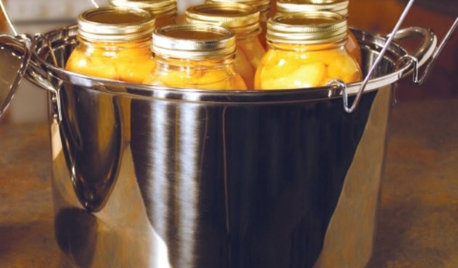best way to preserve bean seeds?
ncstockguy
17 years ago
Related Stories

GARDENING GUIDESSeeds or Seedlings? How to Get Your Garden Started
Growing delicious herbs and vegetables starts with knowing your goals and when you want to plant
Full Story
PRODUCT PICKSGuest Picks: Canning, Preserving, Steaming, Dehydrating
20 products to help make fall produce last through the season and beyond
Full Story
SUMMER FRUITS AND VEGETABLESSummer Crops: How to Grow Beans
Grow your own beans for amazing variety and healthy, convenient produce all summer
Full Story
LIFEThe Top 5 Ways to Save Water at Home
Get on the fast track to preserving a valuable resource and saving money too with these smart, effective strategies
Full Story
FEEL-GOOD HOME21 Ways to Waste Less at Home
Whether it's herbs rotting in the fridge or clothes that never get worn, most of us waste too much. Here are ways to make a change
Full Story
DECORATING GUIDES10 Ways to Give Your Hospitality a Tropical Touch
Treat guests to the resort treatment with blossoms, fruit and artwork that stir up an air of the exotic
Full Story
GARDENING FOR BUTTERFLIES3 Ways Native Plants Make Gardening So Much Better
You probably know about the lower maintenance. But native plants' other benefits go far beyond a little less watering and weeding
Full Story
FARM YOUR YARD9 Ways to Change Up Your Vegetable Garden for the Coming Season
Try something new for edible plantings that are more productive than ever
Full Story
GARDENING GUIDES5 Ways to Naturally Win the Weed War
Show irksome weeds no mercy with these tricks for combating them sans chemicals
Full Story
HEALTHY HOME12 Ways to Set Up Your Kitchen for Healthy Eating
Making smart food choices is easier when your kitchen is part of your support team
Full StoryMore Discussions






JoanofPa
ncstockguyOriginal Author
Related Professionals
Horsham Landscape Architects & Landscape Designers · McKinney Landscape Contractors · Bridgeport Landscape Contractors · Corona Landscape Contractors · Dudley Landscape Contractors · Gaithersburg Landscape Contractors · Harvey Landscape Contractors · La Vista Landscape Contractors · Lake Saint Louis Landscape Contractors · Painesville Landscape Contractors · Suitland Landscape Contractors · Tacoma Landscape Contractors · Newnan Roofing & Gutters · West Chester Roofing & Gutters · Miami Beach Roofing & Gutterszeedman Zone 5 Wisconsin
austransplant
bambi_b
chervil2
gardenman101